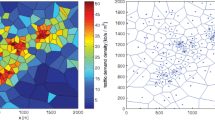Abstract
Cellular networks must be updated very often. Due to technical and economical reasons, the complete channel retuning of an urban network has to be done in several steps. The objective is then to define the steps in such a way that the increase in the interference level is minimum, and do not let it go further than a given threshold of minimum quality for the cellular network. We propose a greedy heuristic and an ascent–descent method including a Tabu Search module to retune a network in a given number of steps. All constraints of the channel assignment problem are taken into account (co-channel, adjacent channel, minimum channel spacing on antennas) as well as retuning constraints such as the number of steps and limits on the maximum number of cells which can be retuned at each step. Co-channel and adjacent channel constraints are expressed through compatibility matrices produced with a discretization of the signal-to-interference ratio. Numerical results are presented on a Bell Mobilité urban network of 359 cells.
Similar content being viewed by others
References
R. Borndörfer, A. Eisenblätter, M. Grötschel and A. Martin, Frequency assignment in cellular phone networks, Annals of Operations Research 76 (1998) 73–93.
A. Gamst and W. Rave, On frequency assignment in mobile automatic telephone systems, in: Proc. Globecom'82 (1982), pp. B3.1.1–B3.1.7.
M. Hata, Empirical formula for propagation loss in land-mobile radio services, IEEE Transactions on Vehicular Technology 29(3) (1980) 317–325.
S. Hurley, S.U. Thiel and D.H. Smith, A comparison of local search algorithms for radio link frequency assignment problems, in: ACM Symposium on Applied Computing, Philadelphia (1996), pp. 251–257.
I. Katzela and M. Naghshineh, Channel assignment schemes for cellular mobile telecommunication systems: A comprehensive survey, IEEE Personal Communications (1996) 11–31.
W.C.Y. Lee, Mobile Cellular Telecommunications: Analog and Digital Systems, 2nd edition (McGraw-Hill, 1995).
Y. Okumura, E. Ohmori, T. Kawano and K. Fukuda, Field strength and its variability in vhf and uhf land-mobile service, Review of the Electric Communication Laboratory 16 (1968) 825–873.
J.P. Warners, T. Terlaky, C. Roos and B. Jansen, A potential reduction approach to the frequency assignment problem, Discrete Applied Mathematics 78 (1997) 251–282.
Author information
Authors and Affiliations
Rights and permissions
About this article
Cite this article
Barbéra, V., Jaumard, B. Design of an Efficient Channel Block Retuning. Mobile Networks and Applications 6, 501–510 (2001). https://doi.org/10.1023/A:1011858020793
Issue Date:
DOI: https://doi.org/10.1023/A:1011858020793




